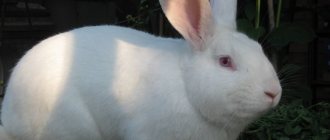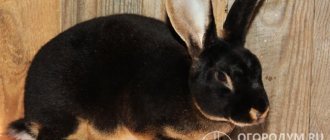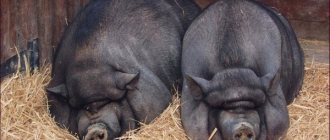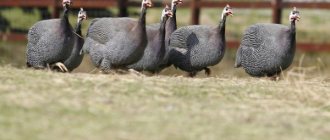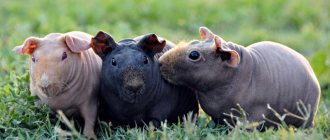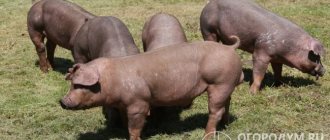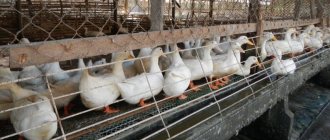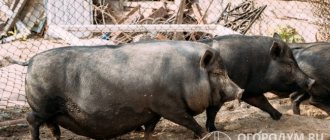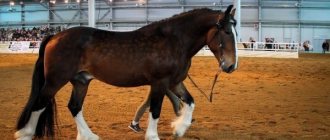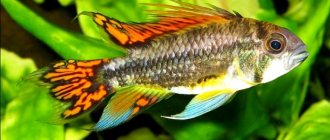Competitions are very popular among rabbit breeders, in which they compete in every possible way in raising long-eared rabbits with excellent qualities and large dimensions. Rabbits of the Risen breed, of course, most often end up on their champion lists, because these “kids” are distinguished by their gigantic size, but at the same time have a very harmless and calm disposition.
History of the origin of the Risen rabbit breed
The first rabbits appeared in the 16th century in Flanders. These were short-haired animals with dense fur of a rich gray color. Even then, long-eared animals were distinguished by their large size, massive build, and powerful paws. The animals weighed 6 kg or more. Riesen's first name was the Belgian Giant.
In the 19th century, rabbits came to Germany, where their mass breeding and selection began. The Germans emphasized weight gain and meatiness of the breed. In 1937, these pets were officially patented as the "German Riesen" or "German Giant". Since then, they have been actively grown not only in Germany, but are distributed throughout Europe.
Not all breeders recognize the purebred nature of the breed, considering the Rizens to be only a branch of the Flanders rabbits. Disputes over a given topic do not stop.
Conclusions.
Currently, all large rabbits, descendants of the Flandre breed, are united into one group of Rizens. In the European Union, this fact is enshrined at the level of the European Rabbit Breeders Association. However, at the same time, the name Flanders itself disappeared. Despite the steps taken to level out the largest and one of the oldest breeds, Flanders are alive and successfully bred in some farms. Their standards and descriptions can be found in current current catalogs of some European countries. Thanks to their unique qualities, they can become a reliable support in purebred selection, in the creation of simple and complex hybrids, and in the improvement of shredded herds. Considering that the breed is quite ancient, its genotype is very stable, with virtually no recessive genes. Belgian Giants are easy to breed, prolific, unpretentious, and take root well on farms and as domestic friends (family members).
Exceptional appearance makes Flanders regulars at major regional and international exhibitions. It must be borne in mind that in the territory of the former Union it is unlikely to find a breeding farm where they would preserve, let alone improve, their genotype. At best, you can buy a Flemish rabbit at fairs, from a breeder who supports his own farm with imported animals. Do not forget to clarify whether they are exactly Belgian Giants or just large “Euro-Saxons”. If they accuse you of incompetence and begin to tell you that Flandre and Risen and Obr are the same breed, please clarify, on the basis of what document? As they used to say, words cannot be matched to deeds.
Please share this article with your friends on social networks:
Please rate the article. Ask a question, discuss on the forum.
Description and characteristics of the breed
The Risen rabbit is a representative of the meat breed, which stands out for its large dimensions and massive physique. These pets are clumsy and clumsy, so it is better to keep them in spacious cages.
Rabbits have a kind, easy-going character. They do not conflict with their relatives, get along well with other animals in the barnyard, and do not fight for territory. Rizens make contact with people without fear, are trained, remember their nickname and the breeder’s simple commands.
Appearance
Rabbits have well-developed muscles. The body is proportional to the head, massive body, wide back and powerful chest. Males have a round muzzle with puffy cheeks, while females have a gracefully elongated muzzle. Rabbits have brown eyes and erect ears that are 13-20 cm long and resemble skittles in appearance.
Most of the rabbits' muscles are located in the lower part of the body, but the front legs are also massive for balance. The length of the body is 65-80 cm, the weight of adults is 10 kg, but there are cases when Rizens grew to 15 kg or more.
Coarse short hair up to 5 cm long. There are representatives of the breed with different fur colors - from blue to dark gray, red shades are not excluded. There are no standards for coat color; it is inappropriate to judge purebredness based on this criterion.
Risen agouti color. Male, 5 months old.
Productive qualities
When breeding Risen rabbits, the emphasis is on the meatiness of the breed. The animals have tender, dietary meat with a pleasant taste, which breeders sell. More often, rabbits are bred only for their delicious meat products.
The animal's valuable fur also deserves attention. Unlike small rabbits, Risen skins are large, with an even distribution of fur, and are highly valued in light industry for making clothes and insulation.
Advantages and disadvantages
Before you start breeding Risen rabbits, study the advantages of this breed:
- flexible character;
- high fertility;
- tasty, dietary meat;
- valuable skin;
- maternal instinct of females.
These pets have their drawbacks, which force breeders to think several times about the right choice:
- slow growth;
- clumsiness;
- aesthetics of the breed;
- high feed costs;
- risk of obesity;
- the need for large cages, enclosures;
- capriciousness in conditions of detention;
- risk of morbidity (weak immunity).
Choosing a good individual
To select healthy and purebred animals, study the breed standards. Otherwise, the value of domestic animals and their products (meat, fur) is significantly reduced. Breeding rabbits are not cheap, and this point is also important to consider when purchasing.
Risen blue. In Holland they call it the Flemish Giant.
Basic Rules
Buy Risen from a breeding farm where the breeder has certificates and there is no doubt about the purebred of the breed. Buying a rabbit at the market promises disappointment, since the animal may not be a purebred, but a half-breed.
Other recommendations when choosing Rizenov:
- Buy rabbits when they are 3-4 months old.
- Choose spring-fed animals.
- Do not purchase adult rabbits for breeding.
- Choose healthy individuals: well-fed, with a straight back and even coat.
- Make sure your animals have a correct bite and healthy teeth.
- Examine the ears: they are erect, without mucus or flaking inside.
When choosing, do not lift the animal by its hind legs or ears. In the first case, a tendon rupture may occur, in the second - severe fright up to cardiac arrest.
Signs of purebredness
Breeding rabbits are much more expensive. In order not to buy a Risen with a marriage or a half-breed, pay attention to the following breed standards:
- clean paws;
- sinewy muzzle;
- smooth coat without bald patches;
- erect ears 13-20 cm long;
- adult weight from 8 kg;
- clean ears;
- correct bite;
- absence of caries on teeth;
- a good appetite.
If there is a deviation in 1-3 signs, it is better to refrain from making an expensive purchase. Perhaps the rabbit is purebred, but it is unlikely to reproduce healthy offspring.
Red Risen. Male. In the photo he is a little over 3 months old.
Signs of culling
Among professional breeders, there are certain parameters by which pets are culled. Among them:
- short, drooping ears;
- narrow pelvis in females;
- weight less than 8 kg;
- bald patches on fur;
- weak, deformed paws;
- flattened muzzle;
- malocclusion;
- carious teeth.
Productive qualities
The meat of giants is dietary, soft and juicy.
Highly rated by customers:
- with small children;
- who require high-quality and gentle nutrition;
- athletes who scrupulously monitor their form.
The smooth and warm fur of the Rizens is happily bought by large specialized factories.
Maintenance and care
Animals need quality care. This is not only the choice of a large and capacious cage, but also keeping the rabbits clean, proper feeding, preventive vaccination, and a timely response to the first symptoms of the disease. Otherwise, entire nests of rabbits die.
Content principles
Risen rabbits have difficulty adapting to the Russian climate and cannot tolerate severe frosts. The main task of domestic breeders is to create the necessary conditions for raising and breeding domestic animals.
Do not forget that in a damp and dirty room the Rizenov’s immunity weakens, and the rabbits will soon die. Another danger for pets of all ages is the destructive influence of drafts and scorching sunlight.
Features of cell arrangement
Rabbits are large and need spacious cages. It is important that the Rizens do not crowd each other and do not become aggressive. The optimal cage dimensions are 100×110×75 cm, for a female rabbit after birth – 170×110×50 cm.
Other recommendations for arranging a home for rabbits:
- Maintain the temperature in the barn: at least 5 degrees in winter and no more than 40 degrees in summer.
- Observe the permissible humidity limit - 60-75%, otherwise the animals will get sick.
- Place a layer of straw or a hay mat on the bottom of the cage to prevent the long-eared animals from damaging their paws on the metal bars.
- Arrange windows on the south side, provide a diffused flow of light.
- Use additional lamps for lighting.
- In each cage, place a spacious feeder and sippy cup. Clean dishes as they become dirty.
- Take care of high-quality ventilation, ventilate the room regularly.
Care and hygiene
To ensure that animals do not get sick, remain active and fertile, it is important to properly care for them. Dry and clean cages are the key to the health of Risen rabbits. The list of valuable recommendations does not end here:
- Make sure there are no cracks in the barn where rodents and other pests can enter.
- According to the plan, thoroughly disinfect the barn 2 times a year.
- Clean the cages daily, refresh the food, and add clean water to the sippy cups.
- Change the bedding in the cages regularly to avoid dampness.
- Avoid direct sunlight, otherwise the rabbit will die in the heat.
- Set up the enclosure, make sure there are no poisonous grass or foreign objects.
- Keep the enclosure clean and tidy.
- Regularly inspect the fur and ears of animals for bald spots and parasites.
- To comb out, use a stiff bristle brush.
Serious mistakes made by rabbit breeders
- The cages are too cramped and the animals are overcrowded. Beginner rabbit breeders, in order to save space, often try to either make cages of the minimum size allowed, or put two or three animals in one cage. It would seem that two rabbits would fit quite well in enclosures for Risen, but female rabbits with six to nine heads of grown-up rabbits can fit there.
- Feeding with pig feed. In an effort to get their rabbits to gain weight as quickly as possible, some rabbit breeders feed their animals pig feed. Considering that the characters are already prone to obesity, this method will probably help to quickly achieve results. But the fiber in this food is three times less than the minimum required for a rabbit. Due to the lack of fiber, the bacteria in the cecum that produce the amino acids and vitamins necessary for the rabbit will die. The consequence of such “progressive” feeding will be dysbiosis and vitamin deficiency.
- Access of mice and rats to food. Many people neglect the capital construction of a feed warehouse, believing that since the feed is not stored near the rabbits, then there are no threats. Apart from the fact that rodents will definitely find and spoil the food, newcomers to the business face a more serious danger. Both rats and mice defecate directly on the food. In fact, where they eat, they shit. Everything would be fine, even the smell can be tolerated, but these rodents are often sick with salmonellosis. Salmonella persists in the external environment for several months. Once the infection gets into the rabbits' gastrointestinal tract along with the food, the infection will quickly spread throughout the farm. Salmonellosis is also dangerous for humans.
What to feed Risen rabbits?
Animals need a clean drinking bowl with a renewed portion of water. Feed rabbits 3 times a day, at regular intervals, to avoid obesity in adults. The basis of the Risen's daily diet:
- green feed;
- roots;
- tree branches;
- vegetables;
- feed;
- vitamin, mineral supplements;
- river sand, bone and meat meal.
The rabbit receives vitamins and nutrients from fresh meadow grass. Give this ingredient in a dried form, otherwise the animal’s digestion will be impaired. appetite worsens.
For the winter, stock up on hay and feed, remember the benefits of brooms made from branches and wet mash. Rizens love fresh fruits; in addition to vitamins, they get water from them. In summer, not a single feeding is complete without fresh fruits.
Dangers of Obesity
A rabbit needs a fortified and balanced diet. The animal should not be overfed, otherwise it will negatively affect its fertility and health. Obesity develops, in which:
- Males are not able to fertilize a female and become less active. The Rizenov's fertility rate is decreasing.
- Overweight female rabbits give birth to fewer babies, and pathologies during labor are difficult to avoid.
Diet preparation
Risen's menu depends on age, gender, and breeding goals. Approximate feeding scheme for a rabbit:
- breakfast: half the daily portion of concentrates;
- lunch: hay or dried grass depending on the time of year;
- dinner: remaining concentrates combined with root vegetables.
Pay special attention to wet mash. Add vitamin and mineral supplements, meat and bone meal, and river sand to them. This food ingredient is especially important during the period of vitamin deficiency (autumn and winter), and is useful for pregnant rabbits.
The rabbit needs a varied diet, and the breeder is offered 2 types of food:
- dry: compound feed, vitamin and mineral supplements;
- combined: liquid and thick mixtures of roughage and green feed, food waste.
Feeding in different seasons
Features of the daily menu of the Risen rabbit also depend on the time of year and climatic conditions. The taste preferences of a pet also matter. The daily diet is:
- Summer. Includes fresh grass, root vegetables, vegetables, feed and mineral supplements.
- Winter. Includes feed, grain crops, tree branches, silage, wet mash, mineral supplements.
Breeding
Rabbits become sexually mature at 3-4 months, but mate only at 8 months. The best producers are selected from different nests. When choosing a male, the following evaluation criteria are taken into account:
- increased activity;
- a good appetite;
- physical endurance;
- no signs of disease;
- Weight is within normal limits (for age).
For 1 male there are up to 5 females. For mating, a separate cage is needed, in which the rabbits remain for 20 minutes. First remove the feeder, drinking bowls, and foreign objects that only distract the animals and disrupt the fertilization process.
There are 2 ways to check whether a female is pregnant or not. For example, gently feel her stomach so as not to provoke a miscarriage. During pregnancy, the belly is dense, elastic, and the rabbit becomes nervous when touched in this way. Second option: after a couple of weeks, re-place the male with the female and observe her reaction. The pregnant rabbit definitely won’t let him near her.
Pregnant female rabbits should eat heavily. In addition to mixed feed and green grass with wet mash, the daily diet requires chalk, bone and meat meal, feed phosphates, and tricalcium phosphates.
Watch the video in which an experienced breeder of Risen rabbits will tell you when and how to mate representatives of this breed:
Arranging a queen cell for a female rabbit
A separate housing is provided for the pregnant female. It should be a spacious cage with clean bedding, fresh food and water. If the drinking bowl is empty, after giving birth the female rabbit becomes aggressive. There are cases when she ate her cubs.
The presence of a removable queen cell is required. This is a rectangular wooden box with a round hole for a hole. To properly arrange it, first of all, protect the queen cell from direct sunlight. Proper distribution of light promotes activity and gradual maturing of rabbits.
The queen cell should not become an extension of the cell, otherwise the rabbit will begin to defecate, eat, and sleep in it. Buy such a device in a special store or make it yourself. In fact, the queen cell is an appendage of the cell, which seems to have a separate entrance.
Shortly before giving birth, the female rabbit sets up a nest. She collects everything that comes under her paws into a heap, and can even tear out her own fur from her chest. This process, which awakens the maternal instinct, cannot be disrupted. The breeder must understand that the litter will occur in the near future.
Climatic conditions and temperature conditions for breeding
To breed rabbits, it is important to exclude drafts and direct sunlight. In the heat, animals do not feel comfortable and may even die. Drafts have a negative impact on undeveloped immunity, and all offspring can suffer.
When keeping Risen, cool the pens in hot weather and heat them in winter. A shady tent under which a grazing rabbit can hide from the intense heat will not be amiss. In summer, make sure the sippy cups are always full.
Okrol
Rabbit pregnancy lasts 30-40 days. As birth approaches, the rabbit's behavior changes. She becomes aggressive and fussy or, conversely, too calm and sleeps a lot. Appetite and thirst increase, the desire to build a nest becomes fanatical. These are characteristic signs of impending labor.
The female gives birth at night or early in the morning. In a litter there are up to 8-12 rabbits, which the heroine mother carefully looks after. Always having clean water in the drinking bowl significantly reduces the risk of cannibalism. The next offspring of a female rabbit may appear in 8-10 months.
Care and feeding
Immediately after birth, babies are breastfed. Female rabbits have a well-developed maternal instinct and lactation is established. For the first week, the young animals eat only mother's milk, after which chopped potatoes with steamed bran are added to their diet. After a month, the animals eat like adults.
Initially, rabbits need 4 meals a day, but as they grow older, they are transferred to the 3 meals a day regimen (like adults). It is necessary to have clean water in the sippy cups and intensive feeding of the female rabbit after giving birth.
Sometimes it happens that the mother rabbit does not produce milk or she refuses the rabbits - then you will have to feed the babies yourself, and our article “How and how to feed newborn rabbits without a rabbit” will help you with this.
Lactation stops after 2 months. By this time, the young animals must be transferred to the full nutrition of adults, otherwise weight gain will slow down. To quickly accustom animals to new food, include wet mash in their daily diet.
Baby rabbits
The farmer's future earnings depend on caring for the rabbits. In order for the offspring to grow healthy and large, simple rules should be followed. It is necessary to ensure that the cage where the rabbit and baby rabbits are kept is clean and that there is always fresh and clean water inside. It is also recommended that all necessary vaccinations be completed by a veterinarian.
The first vaccination is given 15 days after the pet is born. The second one is given 14 days after the first vaccination. A month later they do the final one.
Giant rabbits need to be fed a lot and often. To gain weight, Rizens are given boiled potatoes with bran. Rabbits grow and gain weight up to 12 months, and a nursing rabbit on this food quickly recovers after giving birth and has a large amount of milk to feed the young.
Some livestock breeders give young animals a special starter feed that contains all the necessary vitamins and minerals.
In winter, you need to give food a little warmer than usual. This measure is necessary so that individuals can keep warm in winter, even if they are kept indoors. You should give enough wet mash so that your pets can eat it all at once. This is especially true for liquid mash, which often spoils, and Risen rabbits are so picky that they may not eat food that has been sitting for a while.
Diseases
Monitor the health of your livestock. If one rabbit gets sick, the entire nest can die. Dangerous diagnoses:
- Myxomatosis . The digestive tract is damaged, resulting in a rash and large ulcers appearing on the body.
- Coccidiosis . This is a parasitic disease that, when corroded by the mucous membrane of the digestive tract, can lead to the death of a rabbit.
- Pasteurellosis. An infectious disease, especially dangerous for rabbits. All offspring may die.
- Infectious stomatitis. Affects the oral mucosa. The animal first refuses food, then dies from exhaustion.
- Rhinitis. This is a consequence of drafts and temperature disturbances when keeping Risen rabbits.
Myxomatosis in rabbits
Coccidiosis in rabbits
Pasteurellosis in a rabbit
Rabbit with infectious stomatitis
The nose of a rabbit with rhinitis
Vaccination
Risen rabbits, like representatives of other breeds, are prone to diseases. To avoid the death of the entire livestock, take care of preventive vaccination in a timely manner. The following vaccination scheme is provided:
- The first vaccination against VGBV is carried out at 1.5 months, and the veterinarian must make sure that the animal is healthy.
- The second vaccination, against myxomatosis, is performed on the rabbit 2 weeks after the previous one.
- Revaccination against VGBV is carried out after another 2-3 weeks, depending on the condition of the animal.
- After the same time interval from the previous one, revaccination against myxomatosis is done.
Reviews
★★★★★
Margarita, 45 years old, farmer, Minsk. My Rizens have been living with me for several years now.
The positive aspects: a large carcass of meat and valuable fur. That's all. There are more disadvantages, starting with certain feed, which is expensive and ending with the eternal sickness of these animals. I keep them out of habit, although I plan to have a breed of rabbits that is more prolific and less troublesome to care for. ★★★★★
Maxim, 48 years old, farmer, Elektrostal. These rabbits are not suitable for breeding in our climatic conditions.
The slightest draft, they get sick and die. Yes, they are large and weighty, but the cost of maintaining them is not worth it. Animals are very picky eaters. Almost as soon as they eat it, they are immediately poisoned. You have to constantly change the feeder and add fresh water. This is a very troublesome matter. ★★★★★
Ilona, 52 years old, agriculture, Sochi. Rabbits need warmth and space.
When I started a nest, I put them in a cage, they were so aggressive. For a long time I didn’t understand what was what. Then I read it and found out that animals need space. My husband had to arrange new cages for them. But the problem was immediately solved, the animals stopped being nervous and reproduced well. ★★★★★
Svetlana, 47 years old, Trekhgorny, Chelyabinsk region. We liked these bunnies.
They are truly giants! We bought two-month-old rabbits on the website https://eurokrol.ru, their weight was up to 3 kg. By the time we reached 10 kilograms! Hide
Add your review
Risen rabbits attract people with their size and well-groomed fur. Before breeding such an animal, provide it with spacious cages and a clean and dry enclosure. Next, take care of quality nutrition and preventive vaccinations for age. With a competent approach to the issue, breeding Rizens is a troublesome, but profitable task.
0
0
Copy link
How did Flanders appear?
Historical documents did not record the algorithm of action of the breeders of that time. The source material was local individuals. According to some information, only the selection of large parents was carried out over many generations. According to others, the local Flemish rabbit was crossed with someone else. One version mentions the wild Argentine Patagonian rabbit, which later became extinct in its homeland. I will not list other versions. They all have the right to exist, but only as versions and cannot give us anything definite at the present time.
Just for the sake of clarification, I will add that all breeds of rabbits are man-made and belong to the family - the common rabbit or the European wild rabbit. Therefore, if we look even further back into centuries, we can say with confidence: the distant ancestors of Flanders are wild European rabbits. But history is generally silent about the path they took to become local savages (the immediate ancestors of domesticated individuals). Perhaps none, or perhaps people somehow participated in the preliminary improvement through selection for the tribe.
There IS also an alternative name for the mentioned region of Belgium. Flanders is also called the Flemish region. Hence the second popular name of the Flanders breed - Flemish rabbits. But the most popular and accurate name for this group of animals is the Belgian giant breed. This is the name that appears in documents describing rabbit standards.
Initially, Flanders rabbits represented a group of animals of small numbers, limited to the region. In size, they clearly did not reach the current representatives of the Belgians. Their weight did not exceed 5 kg. Currently, this is the largest and one of the most popular breeds in the world. Some Flandres reach fantastic sizes, more than 20 kg, for which they are awarded places in books of records and awards at major international exhibitions. Now every self-respecting country, in terms of industrial rabbit breeding, considers it necessary to have its own large breed, not inferior to Flanders in size. And many succeeded, to a greater or lesser extent.
